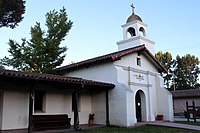
Photo from wikipedia
Relative crustal motions along active faults generate earthquakes, and repeated earthquake cycles build mountain ranges over millions of years. However, the long-term summation of elastic, earthquake-related deformation cannot produce the… Click to show full abstract
Relative crustal motions along active faults generate earthquakes, and repeated earthquake cycles build mountain ranges over millions of years. However, the long-term summation of elastic, earthquake-related deformation cannot produce the deformation recorded within the rock record. Here, we provide an explanation for this discrepancy by showing that increases in strain facilitated by plastic deformation of Earth’s crust during the earthquake cycle, in conjunction with isostatic deflection and erosion, transform relative fault motions that produce individual earthquakes to geologic deformations. We focus our study on the data-rich Santa Cruz Mountains, CA, USA and compare predicted and observed quantities for rock uplift, apatite (U-Th)/He thermochronology, topographic relief, 10Be-based erosion rates, and interseismic surface velocities. This approach reconciles these disparate records of mountain-building processes, allowing us to explicitly bridge decadal measures of deformation with that produced by millions of years of plate motion.
Journal Title: Science Advances
Year Published: 2022
Link to full text (if available)
Share on Social Media: Sign Up to like & get
recommendations!